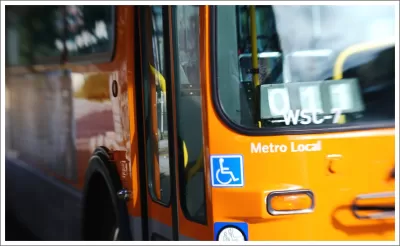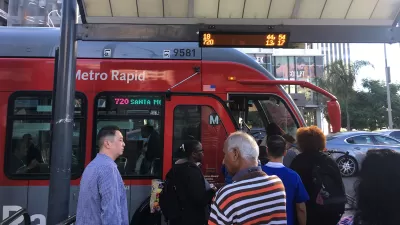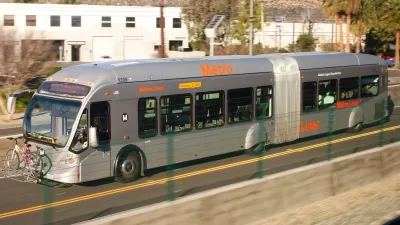One of the largest transit systems in the country continues to lose large numbers of riders. But the causes behind the drop and the solutions to stop it are hard to pinpoint.

Laura J. Nelson reports on the current state of transit ridership in Los Angeles County. The Los Angeles County Metropolitan Transportation Authority’s bus system alone has seen a drop in ridership of 25 percent, or 95 million trips, in the last decade.
The reasons for the decline vary and include a stronger economy—when people buy cars—and a decrease in immigration as well as a network of bus service that critics say does not meet the needs of riders.
"The bus exodus poses a serious threat to California’s ambitious climate and transportation goals. Reducing traffic congestion and greenhouse gas emissions will be next to impossible, experts say, unless more people start taking public transit," writes Nelson.
The solutions are varied as well. Metro has its eye on bringing in new riders who now drive by speeding up travel times and by better targeting service to places people need to go. But transit advocates say that improvements should focus more on the needs of existing riders, many of whom are Latino and black and are dependent on transit. They want Metro to put in more bus-only lanes and implement all-door boarding to decrease travel times, and they want to see more buses on the streets.
Still, the challenges to increasing ridership on buses in Los Angeles are immense. "When someone buys a car, they become less likely to take transit and more likely to drive, studies show. Non-car owners now have more alternatives than ever, including Uber and Lyft, car-sharing services like Zipcar, and rental bikes and scooters," notes Nelson.
FULL STORY: L.A. is hemorrhaging bus riders — worsening traffic and hurting climate goals

Alabama: Trump Terminates Settlements for Black Communities Harmed By Raw Sewage
Trump deemed the landmark civil rights agreement “illegal DEI and environmental justice policy.”

Study: Maui’s Plan to Convert Vacation Rentals to Long-Term Housing Could Cause Nearly $1 Billion Economic Loss
The plan would reduce visitor accommodation by 25% resulting in 1,900 jobs lost.

Why Should We Subsidize Public Transportation?
Many public transit agencies face financial stress due to rising costs, declining fare revenue, and declining subsidies. Transit advocates must provide a strong business case for increasing public transit funding.

Paris Bike Boom Leads to Steep Drop in Air Pollution
The French city’s air quality has improved dramatically in the past 20 years, coinciding with a growth in cycling.

Why Housing Costs More to Build in California Than in Texas
Hard costs like labor and materials combined with ‘soft’ costs such as permitting make building in the San Francisco Bay Area almost three times as costly as in Texas cities.

San Diego County Sees a Rise in Urban Coyotes
San Diego County experiences a rise in urban coyotes, as sightings become prevalent throughout its urban neighbourhoods and surrounding areas.
Urban Design for Planners 1: Software Tools
This six-course series explores essential urban design concepts using open source software and equips planners with the tools they need to participate fully in the urban design process.
Planning for Universal Design
Learn the tools for implementing Universal Design in planning regulations.
Smith Gee Studio
Alamo Area Metropolitan Planning Organization
City of Santa Clarita
Institute for Housing and Urban Development Studies (IHS)
City of Grandview
Harvard GSD Executive Education
Toledo-Lucas County Plan Commissions
Salt Lake City
NYU Wagner Graduate School of Public Service





























